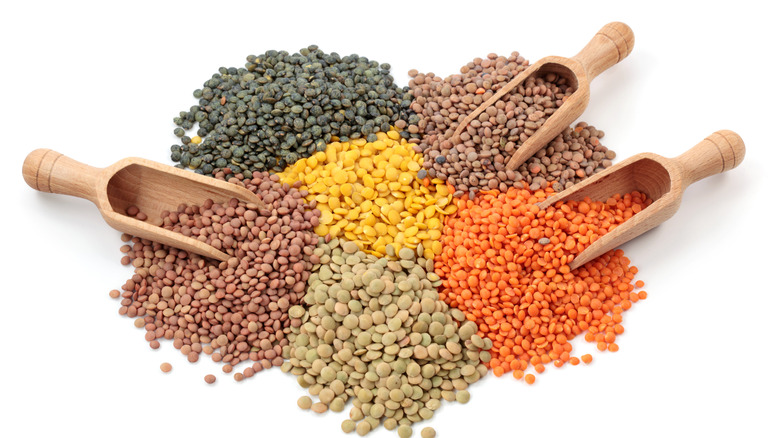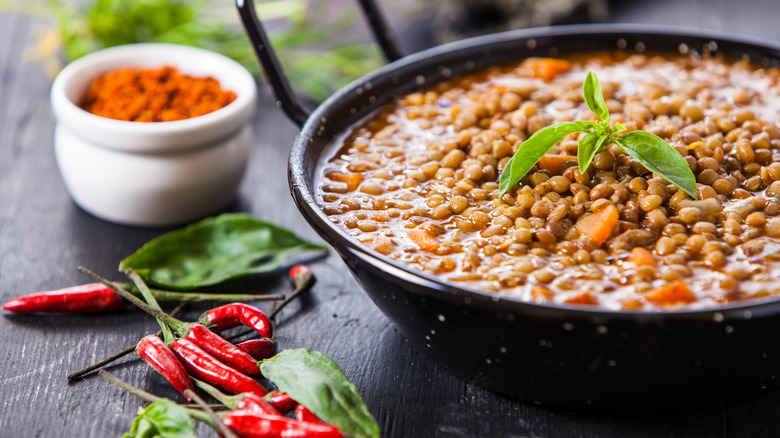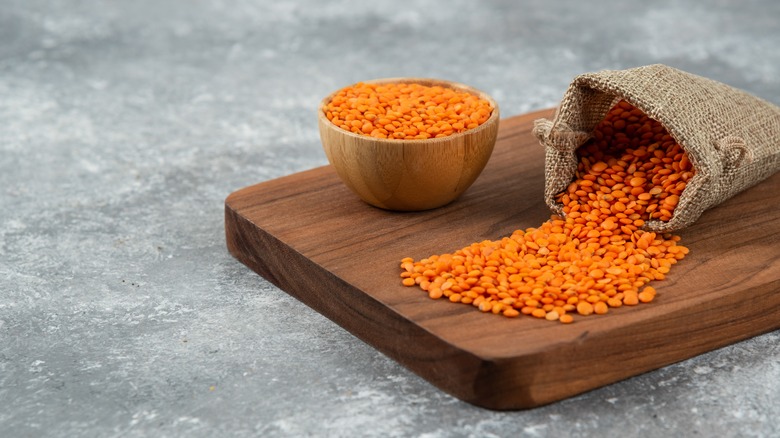The Soaking Trick To Cut Lentil Cooking Time In Half
Some home chefs give up entirely on cooking lentils, especially in countries that don't prioritize them for everyday meals. That's understandable since making the perfect pot of lentils sometimes seems like a culinary (and cultural) art form. But that doesn't mean it's difficult to learn the techniques. In fact, it comes down to a few simple insider tricks, starting with soaking and cooking times.
While soaking lentils before turning them into your favorite daal dish, lentil soup, or spiced curry stew isn't strictly required, it's still a good idea, especially if your lentils have been lingering very long in a grocery store or home pantry. Lentils older than a few months can dry out and either split or become extra hard, taking forever to soften during the cooking process.
Soaking the lentils can bypass this problem, but you'll need to be patient. A minimum four-hour to overnight soak in freshwater is necessary for the ultimate softening effect — and it can even halve the cooking time, eliminating the need to "babysit" that simmering pot of soon-to-be creamy deliciousness.
And that's not all. Giving your brown, green, red/yellow, beluga black, or French puy lentils a long water bath does way more than quicken their way to the table.
Science and nutrition aspects
Nutritional value and digestion come into play when prepping your lentils for a healthy, comfort-food meal. Once again, a water soak initiates the potential benefits.
Steeping uncooked lentils in water helps alleviate their well-known indigestion side effects, especially for anyone unaccustomed to consuming them. It results from soluble carbohydrates in lentil seeds, known as raffinose family oligosaccharides (RFO), which the human body has a hard time digesting, explains the University of Saskatchewan. That's when the gas, bloating, and stomach discomfort appear.
Fortunately, pre-soaking those lentils for at least four hours or even up to 24 hours can remove the troublesome RFO, plus activate compounds that break down complex starches, making them easier to digest. That's a big plus for enjoying lentils both during and after embracing their goodness.
Then there's the nutrition-based soaking magic. A prolonged water plunge allows your body to absorb the valuable nutrients and minerals tucked inside those little flat, round lentil legumes, including iron, zinc, and calcium. With scores of health benefits tied to eating lentils, that's no small thing.
Healthline points out the 25% protein composition of lentils, making them an "excellent meat alternative," as well the extraordinarily high Daily Value (DV) percentages in a cup of cooked lentils, such as 90% folate, 43% manganese, and 55% copper. They're also super high in fiber and contain plant-compound phytochemicals that can help prevent heart disease and Type 2 diabetes, and potentially halt the growth of cancer cells.
How to soak and cook lentils
Now you know why you should submerge those pretty little lentils in a big pot of water before they reach the stovetop or pressure cooker. Next comes the "how" — and it's pretty straightforward.
Choose a large pot or bowl, place the lentils in the bottom, and rinse several times to filter out any potential dust or debris. Then fill the pot with cold water and let them soak in a safe place for four to 24 hours, especially if your goal is to cut the cooking time in half.
When you're ready to start your lentil cooking adventure, drain off the water, give them a final rinse, and start creating your own lentil masterpiece. Be sure to simmer gently to prevent splitting and a resulting squashed texture.
Avoid adding any salt at this point, and hold off on acidic flavorings such as lemon juice, as they can keep the lentils from softening as they simmer. If you want to add salt, vinegar, and other similar flavorings, add them later to the rinsed cooked lentils, while they're still warm and steamy.


